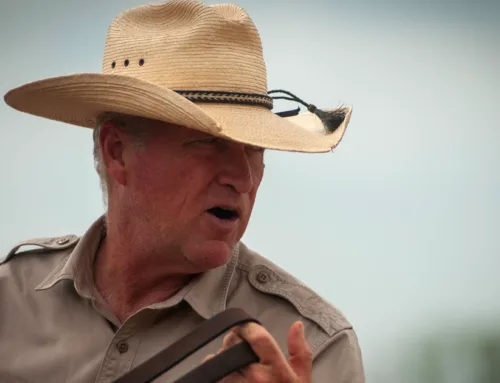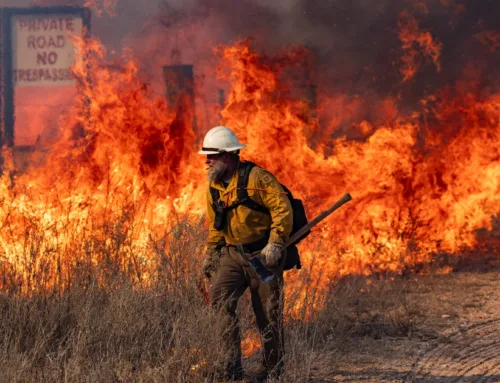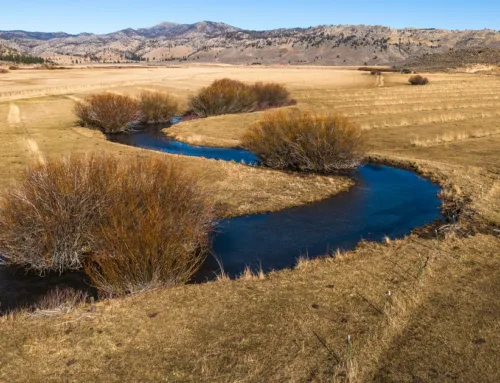T. Boone Pickens: The Land Report Interview
T. Boone Pickens: The Land Report Interview
By Eric O'Keefe

LR_TBP-01
Outside, the Midwest summer sun has pushed the temperature well above 100. Inside Topeka’s Heritage Hall, it’s standing room only, and there’s still half an hour to go before Kansas Gov. Kathleen Sebelius takes the stage to introduce T. Boone Pickens at the very first Pickens Plan town hall meeting. The fire marshal has already collared building personnel and informed them that the capacity crowd of 500 exceeds the city’s fire code. Over the next half hour, hundreds more show up. All are barred from entering, yet not one of them turns away. Instead, they choose to sit outside in the scorching heat and listen in over the public address system.
Pickens Plan Army
Farmers in overalls and work boots, school kids in jeans, a Senate candidate in the requisite blue blazer and repp tie – the Pickens army is mustering for its first official review. The focus of its mission–to develop renewable energy sources such as wind and solar power and use them along with other domestic fuels to curb America’s addiction to foreign oil–is a natural fit for Kansas.
Crops, cattle, oil and gas — the Sunshine State is a commodities-producing powerhouse, and today’s gathering lures Republicans and Democrats, rural folk and city slickers, entrepreneurs and environmentalists. Furthermore, the state sits smack-dab in the middle of the nation’s Wind Belt, a 1,000-mile corridor extending the length of the Great Plains from West Texas to the Canadian border that according to Department of Energy estimates can produce 20 percent of the country’s electrical needs.
This enormous untapped power plant is one of the central pillars of the Pickens Plan, and its importance is emphasized by Governor Sebelius as she introduces Pickens. Confident and easygoing with her constituents, she puts the “town” in town hall meeting by setting a comfortable, conversational tone. The governor points out that Kansas is one of the windiest states in the country “even when the legislature is not in session.”
Boone Pickens Takes Center Stage
After the laughter subsides, Pickens accepts the microphone. He spends the next hour briefing his troops: detailing the progress of the Pickens Plan, emphasizing how he hopes the country’s energy plight will take center stage in the presidential campaign, and encouraging the audience to monitor developments in real time at www.PickensPlan.com.
He acts anything but his 80 years, pacing back and forth on stage as he cites an endless list of figures off the top of his head, ranging from the demand for oil domestically and around the world to production percentages for energy in the US. In his trademark whiteboard presentation, he details the possibilities for reducing America’s dependence on imported oil by more than 30 percent by the end of the next decade. His solution? Use wind energy for power generation, and shift part of the country’s natural gas production into transportation for fleet operators and mass transit.
A good portion of the meeting is reserved for questions from the audience. A wide array of topics is broached. As the Q&A progresses, it becomes apparent that the Pickens Plan is starting to take on a life of its own. The idea of securing America’s energy security casts a wide net. Trained as a geologist at Oklahoma State, Pickens has spent five decades in the petrochemical industry. Now he’s being asked to discuss a much broader range of topics: rechargeable power cells, specific local utility regulations, and the possibility of utilizing geothermal energy.
On several occasions, Pickens hammers home a point by bringing up his wife, Madeleine, and the key role she played in instigating the Pickens Plan. At home late at night or during their travels, she was the one most likely to have to listen to his insistent complaints about the country’s lack of an energy plan. “Why are you always telling me about this?” he tells the crowd she would ask him. “Why don’t you just do something about it yourself?” Heads nod among the couples in the audience. The fact that the Texas billionaire has a wife who tells him to put up or shut up wins big points.
The biggest applause line occurs when the career oil man is faced with a question about fuel cells and alternative energies. Caught flat-footed, he admits his ignorance and then quickly parries with a question of his own about the energy source.
“Is it American?” he asks. When informed that it is, he responds, “Then I’m for it. I’m for anything American.” The crowded hall bursts into cheers.
Although a great deal of effort went into the logistics and planning of the first Pickens Plan town meeting, in essence it was a throwback to the sort of political barnstorming rarely seen nowadays.
Whistle Stop Tour
Unscripted, deeply personal, and punctuated by quick wit and pithy quips, it was as close to Harry Truman’s 1948 Whistle Stop Tour as America is likely to see in this day and age. The populist appeal of the messenger has proven to be a crucial factor in the success of the Pickens Plan.
Backing it up, however, is a $58 million marketing campaign funded by Pickens himself that is built around a barrage of TV commercials and a full-out assault on the Internet. Pickens and his plan can be accessed via his Facebook page, his MySpace profile, LinkedIn, Twitter, and YouTube. Newsweek has labeled the 80-year-old “the Web’s first senior blog star,” and the success of his website proves it. Since its launch in early July, www.PickensPlan.com has become one of the most popular sites on the Internet. More than 250,000 have signed up as supporters; the number of visits has surpassed 6 million. According to Quantcast, it ranks as one of the top 1,000 worldwide.
The First Billion is the Hardest
Throughout his career, Pickens has developed a repertoire of sayings he calls Booneisms. I got to hear many of them firsthand earlier this year when I assisted him by editing his memoir The First Billion is the Hardest (Crown), which has just arrived in bookstores and has already made The New York Times bestseller list. Many of them are straightforward, including this favorite of mine:
“As my father used to say, ‘There are three reasons we can’t do it. First, we don’t have the money, and it doesn’t make a damn about the other two.’” Other Booneisms are character builders more in the tradition of Ben Franklin: “Show up early. Work hard. Stay late. Work eight hours and sleep eight hours, and make sure that they are not the same eight hours.”Pickens increases the reach of his message with a torrent of media appearances. Wolf Blitzer, Neil Cavuto, Lou Dobbs, Don Imus, Larry King – he’s appeared on all of their shows as well as ABC’s Nightline, CNN’s American Morning, NBC’s Squawk Box, NPR’s Morning Edition, and CBS Evening News with Katie Couric. The day of the Topeka town hall meeting his first stop was in Wichita, where he sat down for an hour-long meeting with the Op-Ed board of the Wichita Eagle, a process he has repeated with The New York Times, The Wall Street Journal, The Washington Post, The Washington Times, The Los Angeles Times, The San Francisco Chronicle, and the Chicago Tribune, among others.
A Fool With a Plan
The one he uses to describe his energy plan goes right to the point: “A fool with a plan can outsmart a genius with no plan any day.” Pickens initially outlined his ideas for reducing the country’s dependency on foreign oil in the final chapter of The First Billion, which he titled “The Big Idea: An Energy Plan for America.” It’s an audacious proposal that relies as much on forward thinking as it does his decades of experience.
“Over the next fifty years the United States is going to need much more wind, solar, and other alternative energies. We have to get into these businesses. There’s no way we can generate the energy we need the way we’re doing things today. The future is in renewables. We need a visionary step forward. We need leadership to say, ‘This is what we must do to win the war against foreign oil and end our dangerous and fatal addiction. Here’s a new idea. A bold idea,’” he writes.
Mesa Vista Ranch
This bold idea came to Pickens on his Mesa Vista Ranch in Roberts County, Texas. “It’s where I call home,” he writes. “I honestly cannot tell you how much I enjoy being on my ranch. I’ve given serious thought to living in Roberts County and commuting to Dallas.”
Pickens first set eyes on the Panhandle property in the early 1960s while quail hunting. In 1971 he acquired his initial tract, a 2,940-acre parcel along the Canadian River. Since then the Mesa Vista has grown to more than 68,000 acres with 24 miles of frontage along the Canadian. (Follow the river 300 miles downstream and one arrives at Pickens’ hometown of Holdenville, Oklahoma.)
Pickens has spent millions improving the ranch, putting in more than 50 miles of water lines and planting more than 10,000 mature sycamores, cottonwoods, pines, pears, and lilacs. To accommodate his Gulfstream 550, he installed a 6,000-foot concrete runway complete with adjacent hangar. The Mesa Vista’s two magnificent residences redefine the term “home on the range.”
Pickens long believed that the Mesa Vista’s most important resource was its wildlife: Pronghorn antelope, white-tailed and mule deer, turkey, pheasant, and blue and bobwhite quail. In the eastern reaches of the Texas Panhandle, the demand for outstanding recreational properties is far greater than cattle ranches. Thanks to the rugged terrain, irrigated farming is rarely an option. There was the one critical aspect to the Mesa Vista that the lifelong oil man couldn’t get over. “It’s the only place I’ve ever been where I couldn’t drill a dry hole,” he says. Beneath his 100-section ranch, the same Ogallala Aquifer that waters huge commercial farming operations farther west can be found. Only no one was using it.
Stranded and Surplus
Pickens describes this water as “stranded and surplus.” He became so intrigued by the possibilities that he formed Mesa Water to market his holdings and those of other Panhandle landowners. According to the Pickens Plan website, he is now the largest private holder of permitted groundwater rights in the country. Although his water project has become a $3 billion deal, to Pickens its true importance is that it led him to the Big Kahuna. “Wind is a $10 billion deal. It’s easier than water. It’s bigger than water. Best of all, it complements water,” he writes in The First Billion.
His willingness to embrace the possibilities of wind power as a hugely profitable renewable energy offers telling insight into the mindset of the legendary entrepreneur who turned Wall Street on its ear in the 1980s when he began drilling for oil on the floor of the New York Stock Exchange. In his New York Times column, Pulitzer Prize winner Thomas Friedman recently described Pickens as “the green billionaire Texas oilman now obsessed with wind power.” Pickens lives up to that billing when he extols wind as practical. With or without production tax credits, it’s profitable. Unlike oil and gas, it has no decline curve. There’s also a huge patriotic component, which Pickens makes clear when he seizes on the fact that America is enriching its enemies by spending four times the cost of the Iraqi war to buy imported oil.
Saudi Arabia of Wind
“We are the Saudi Arabia of wind. Look at this here,” he says. It’s the day after his Topeka town hall meeting, and Pickens is pointing to a map of the United States. Although he’s back in Dallas at the corporate headquarters of his investment firm, BP Capital, he’s still pitching the Pickens Plan. This time it’s to America’s largest landowner. Ted Turner is one of many individuals that Pickens has stress-tested his plan with, including Warren Buffett, New York City Mayor Michael Bloomberg, GE’s Jeff Immelt, Carl Pope of the Sierra Club, Presidents Bush and Clinton, Speaker of the House Nancy Pelosi, Senate Majority Leader Harry Reid, and former Vice President Al Gore. But as the owner of 15 ranches in seven states and approximately 2 million acres of land, he is uniquely capable of profiting from the Pickens Plan.
“Boone,” Turner says, shaking his head in disbelief. “You are the map king. I’ve never seen so many maps in my life.” The two are standing in the main conference room at BP Capital. Hydrographic tables, global wind diagrams, solar radiation charts, elevation data, topographic maps, ranch surveys–every inch of wall space is plastered with different schematics. “That’s where my 500,000 acres is, right around there in the reddest part,” Turner says. He’s pointing to a section of a solar map that details western New Mexico, site of his Armendaris and Ladder ranches. “We could take 100,000 acres of it and cover them with solar panels, and I wouldn’t even know it because I hunt on the other 400,000 acres. I’ve already got it; it’s ready to go,” he says.
Lunch With Ted Turner
A buffet lunch follows. In addition to Pickens and Turner, seated at the table are two members of the BP Capital team: Bobby Stillwell, Pickens’ longtime lawyer, as well as Chris Busbee, who specializes in renewable energies. It’s not the first time Pickens and Stillwell have met with Turner. In the mid 1980s, both Mesa and Turner Broadcasting were considering a run at RCA. Several meetings took place. Nothing much came of the endeavor, a point they all laugh off.
In presenting his plan, Pickens recites many of the same reasons he mentioned at the town hall meeting the day before. With Turner, however, he adds an extra consideration, one of great personal significance.
“Revitalizing rural America is very, very important,” he says. “I came from a small town in Oklahoma. I’ve seen everything just go downhill, downhill, downhill, year after year after year. And I’m convinced that half the kids that come from small towns don’t ever adjust to the big city. They really would like to go back home, but they have no opportunity. There are no careers for them,” he says.
Stranded and Surplus
Pickens singles out the economic impact of wind energy on Sweetwater, the county seat of Nolan County, Texas. A ranching and farming community, Sweetwater’s population peaked in the 1950s before beginning a precipitous decline. High school graduating classes, which once numbered as many as 200, fell to a low of 90. Beginning in 2000, however, wind farms capable of producing more than 3,000 megawatts of electricity have been constructed by Florida Power & Light, Babcock & Brown, and AES Wind Generation. The economic impact has been astonishing.
This year alone more than 1,100 jobs with a payroll of $45 million were directly related to wind energy. School district property taxes paid by wind energy projects exceeded $12 million, and from 2004 through 2010 a total of $24 million will go into new school construction. Pickens’ own wind project will be substantially larger than Sweetwater’s, and the revitalization of Pampa has already begun. Pickens sees this economic upturn extending the length of Wind Belt from Sweetwater through Pampa and north to Goodland, Kansas, Hastings, Nebraska, and beyond.
Landowners Win Big
Pickens singles out another big winner: landowners. According to a study prepared for the West Texas Wind Energy Consortium, royalties paid to landowners in the Sweetwater/Nolan County region will total more than $12 million in 2008. Turner jumps on the figure and begins to quiz Pickens and Busbee on the number of turbines per section, the amount of electricity generated, its market value, and the royalty structure. Natural gas, timber, livestock, ecotourism – his 2 million acres enjoy numerous revenue streams, but none with the potential of renewable energy.
“I love your attitude. By God, it’s my chance to be Boone Pickens’ partner after 30 years of hiatus,” Turner says, before adding, “There has never been such a win-win situation. And we’d have cleaner air, we’d also combat global warming. There’s no downside to this. There is not any downside for America to do this. Right, Boone?
“That’s right,” Pickens says.
By the end of lunch, Pickens has added one more name to the growing list of supporters of the Pickens Plan. As the two get ready to leave BP Capital and fly out to the Mesa Vista Ranch, Pickens points out that some people take umbrage at the thought of putting up 40-story turbines the length of the Great Plains. Turner disagrees:
“I think they look great, and I’m not talking about money. I think they look great because they look clean, and they make my country free.”
Since this story was published, Boone Pickens has subsequently met with both presidential candidates, Senators John McCain and Barack Obama, and attended the Republican and Democratic National Conventions, where he spoke with numerous state caucuses.
Originally published in The Land Report Fall 2008.




